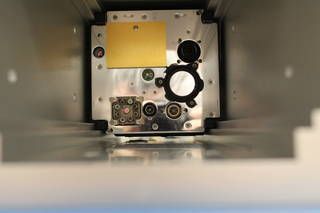By Gary Elinoff, contributing writer
Never let it be said that NASA doesn’t deliver plenty of bang for the buck, because after ferrying supplies to the International Space Station, the Cygnus spacecraft will scoot higher into space and inject two CubeSats into orbit. There, they will conduct a pair of unique communication experiments.
What’s a CubeSat?
A CubeSat is a tiny, cubically shaped satellite. The devices employed in this series of demonstrations are a scant 4 x 4 x 6.7 in. and weigh about five pounds. Their propulsion systems (for making orbital changes) use water converted to steam as their propellant. The obvious benefit of the tiny vehicles is that, because they are so small and weigh so little, they’re cheaper to send into space than larger units. Additionally, specialized deployment systems make it easy for them to flawlessly decouple from the launch vehicle.

A CubeSat. Image source: NanoRacks.
High-speed laser-communication
NASA’s Optical Communications and Sensor Demonstration (OCSD) mission will demonstrate, for the first time, a high-speed laser-based data link coupling a CubeSat in space to a ground station. The benefit, according to Richard Welle of the Aerospace Corporation , is that “The laser communication data rates are orders of magnitude higher than what we can do in radio frequency.” The satellite will use star trackers to determine its orientation and maneuvers the entire satellite to point the laser, which is hard-mounted.
As described by NASA , the high data rate transmission capacity will eventually be used to transmit the huge amounts of data generated in such applications as Earth imaging. An equally exciting concept is the eventual possibility of creating high-speed data networks connecting orbiting CubeSats.

The OCSD CubeSat. Image source: NanoRacks.
Radio transmission of data sped up by four orders of magnitude
The second CubeSat is the foucus of the Integrated Solar Array and Reflectarray Antenna (ISARA) mission, and it will deploy a flat Ka-band antenna, enabling the spacecraft to transmit data at 100 megabits per second, dwarfing the previous standard of 9.6 kilobits per second.
The flat antenna, known as a reflectarray, takes up far less space than the curved parabolic antennas that they replace, freeing up precious space for mission payloads. And, because it’s built via a photolithographic etching process, it is quite inexpensive to produce. Additionally, as implied by the mission’s title, a solar array for capturing sunlight to convert into the satellite's power will be integrated with the reflectarray in this demonstration, further contributing to the space savings.
After the communications testing, it’s time for some space-based acrobatics. The two CubeSats, both orbiting around Earth, will both change orientation to alter their drag and fire their water rockets in order to synchronize orbits and get within 650 feet of each other. As stated by Welle , “The plan is to essentially have one of the satellites orbit the other at smaller and smaller distances.”
According to Elwood Agasid, deputy program manager of the Small Spacecraft Technology Program at NASA’s Ames Research Center , “The short period of development time, the frequency of flight opportunities, and the ability to fly hardware in space to see how it performs in a relevant environment — these small satellites give us a low-cost avenue for in-space validation, verification, and improvement of technology in an incremental fashion.”
Indeed, there is a big future for small satellites.
Advertisement
Learn more about Electronic Products Magazine





